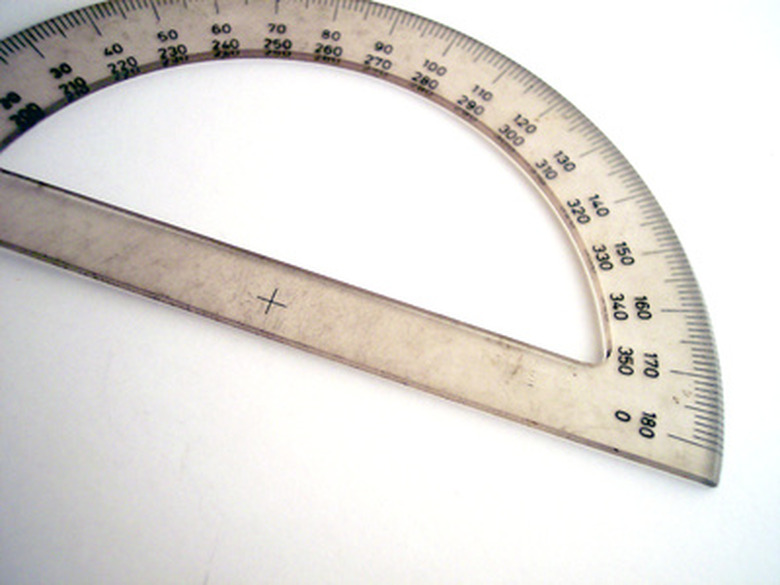Types Of Protractors
A protractor is a mathematical instrument used for measuring, drawing or plotting angles. Its scale, graduated in angular units or degrees, fringes the instrument's upper-edge. Protractors have a vertex mark at their base mid-point from which you can measure all angular directions. The word protractor was first coined prior to 1828. Its invention discontinued the use of the erstwhile line-of-chords. Protractor versions differ in their precision levels.
Semicircular
Semicircular
The semicircular protractor contains two scales each graduated up to 180 degrees in opposite directions for convenient reading from both left and right. The protractor base's mid-point mark indicates the position of the vertex, or highest point of the angle that you are going to measure or draw. You can use this type of protractor for reading, drawing and plotting angles on paper or charts.
Circular
Circular
Shaped like a circle, the circular protractor scale is graduated up to 360 degrees in the clockwise direction from the astronomical north reference point. This unwieldy tool finds little use in school classrooms, but is expansively used in engineering mechanical drawings, architecture and meteorology fields. Some circle protractors are marked in gradians up to 400.
Military
Military
The military protractor symbolizes the azimuth circle. It assists military personnel in determining friend or enemy troop positions on maps. It helps in finding out the grid azimuth from two map points or the angle of the line connecting the two points. It also aids plotting of the azimuth or grid direction line from a given map point.
Square in shape, this protractor features two scales. The inner scale is marked from 0 to 360 degrees. The outer scale is in millimeters. The center or index of this protractor is sited at the intersection of the vertical 180 degree base line and horizontal line. As a rule of thumb, the protractor's 0 degree or 360 degrees must be toward the map's north, and the scale's 90 degrees must be positioned on the map's right side. The base line must be aligned parallel to the map's North-South grid line.
Steel
Steel
The steel protractor is exact to 1 degree. Its variant is the bevel protractor head on a combination square. It is used in woodwork and metal trades to make tools. This instrument is a mechanical protractor as it gauges angles through mechanical contact.
Universal Vernier Bevel
Universal Vernier Bevel
The term "universal" connotes the vernier bevel protractor's suitability for countless work configurations and angle relationships. It is accurate up to 5 minutes, or 1/12 degree. It has a fixed dial or main scale with four sections each graduated from 0 to 90 degrees. The vernier scale has 24 divisions in all — 12 divisions sited on either side of 0. Each division represents 5 minutes. Thus, the vernier scale is bidirectional; it can be read to either side depending on the direction the main scale is revolved. It also has an auxiliary blade for measuring acute angles.
These protractors are used in high-precision, demanding situations in wood and metal toolmaking workshops.
Optical Bevel
Optical Bevel
These nonmechanical protractors eliminate the limitations of their mechanical cousins, such as inexact determination of graduation line concurrences and interpretative mistakes.
This is enabled by a circular glass scale that has a covering to perform the dual function of protecting the scale and veiling irrelevant graduations for greater precision. A magnifying window further aids correct readings by furnishing zoomed-up views of the main scale's exposed graduation in optical coincidence with the reading on a subdivision scale.
Cite This Article
MLA
Faith, Norah. "Types Of Protractors" sciencing.com, https://www.sciencing.com/types-protractors-7345683/. 24 April 2017.
APA
Faith, Norah. (2017, April 24). Types Of Protractors. sciencing.com. Retrieved from https://www.sciencing.com/types-protractors-7345683/
Chicago
Faith, Norah. Types Of Protractors last modified March 24, 2022. https://www.sciencing.com/types-protractors-7345683/
